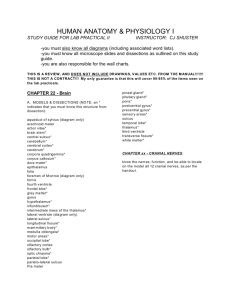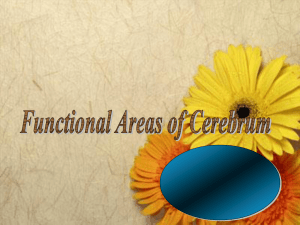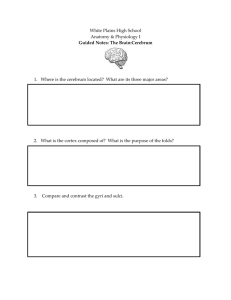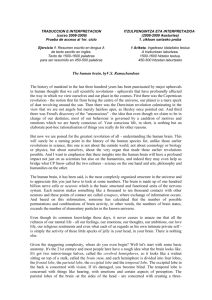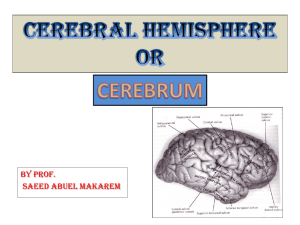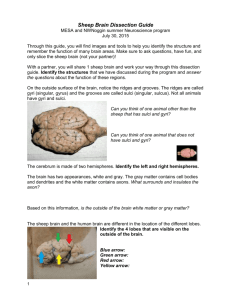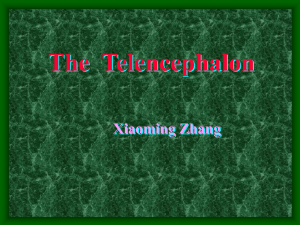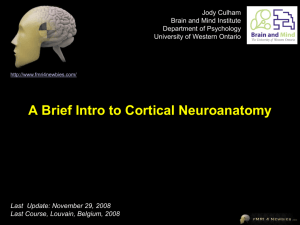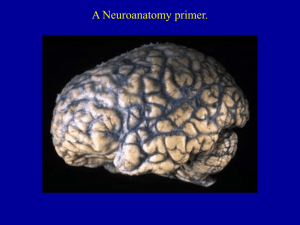School of Anatomical Sciences
advertisement
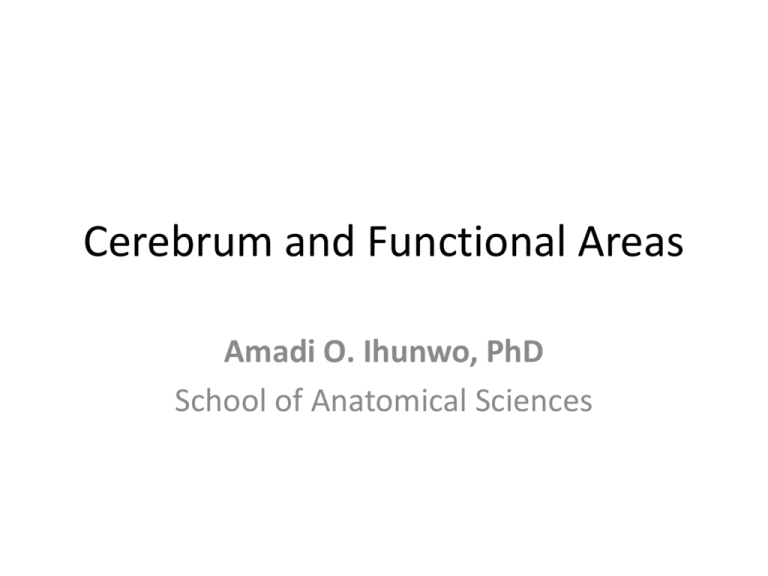
Cerebrum and Functional Areas Amadi O. Ihunwo, PhD School of Anatomical Sciences Lecture Outline • Review sulci and gyri of cerebral hemisphere • Functional Areas Cerebral Hemispheres • Largest part of the brain • Greatest degree of development is in humans • Ocupy the anterior and middle cranial fossae • Consist of an outer cerebral cortex and an inner white matter • A median longitudinal fissure incompletely separates the cerebrum into 2 halves; right and left Gyri and Sulci • • • Gyri – Complicated irregular foldings (convolutions) of surface of cerebral hemispheres Sulci – Intervening grooves between gyri. – May be shallow or deep. – Sometimes deep sulci are called fissures. Gyri & sulci maximise surface of cerebrum; – 70% of cerebrum is hidden in sulci. – Fairly constant, at the same time, vary within certain limits, not only from one brain to another, but within the same brain. Superolateral surface of cerebrum • Lateral sulcus (Sylvius): between frontal, Parietal & temporal lobes. • Central sulcus (Rolando): 1 cm post to midpoint between frontal & occipital pole; Runs downwards & ends just before lateral sulcus; Landmark separating frontal from parietal lobes • Frontal lobe: Largest: 3 sulci: Precentral sulcus, Superior & inferior frontal sulci • 4 gyri: Precentral gyrus, Superior, middle & inferior gyri Parietal Lobe Sulcus: Postcentral & Intraparietal Gyri: Postcentral, superior parietal lobule, inferior parietal lobule with supramarginal & angular gyri Temporal & Occipital lobes • Temporal lobe Lies inferior to lateral sulcus. Sulci: superior & inferior Gyri: superior, middle & inferior. • Occipital lobe Posterior to line joining preoccipital notch to parietooccipital sulcus (medial surface) Lateral occipital sulcus (lunate) o The only fairly constant sulcus on superolateral surface o Calcarine sulcus (medial surface) Medial Surface • • • • • • • Corpus callosum – most conspicuous structure; white matter Cingulate sulcus – intervenes between cingulate gyrus & extension of superior frontal gyrus. Paracentral lobule Middle frontal gyrus Precuneus, Cuneus & Lingual gyri Parieto-occipital sulcus Calcarine sulcus – Occipital lobe Inferior Surface • Divided into 2 parts Small Ant. (orbital part): – olfactory sulcus, gyrus rectus; – H-shaped sulcus with anterior, posterior, lateral & medial orbital gyri Large post. part: – Collateral sulcus, – occipito-temporal sulcus, medial and lateral occipitotemporal gyri, – parahippocampal gyrus Uncus: hook-like projection at anterior end of parahippocampal gyrus INSULAR LOBE • Location: – floor of lateral sulcus; seen only when temporal & frontal lobes are separated • Opercular: parts of frontal, parietal & temporal lobes that overlie insula. • Outlined by a circular sulcus divided into 2 regions by a central sulcus • 3-4 short anterior gyri • 1-2 long posterior gyri • Function:Poorly understood but associated with taste, vestibular, visceral sensation, secondary somatic and auditory. Diagram of Lobes & sulci of the Cerebrum Medial surface Superolateral surface Functional Localization • Cerebral cortex is necessary for conscious awareness and thought, memory and intellect. • It is the region to which all sensory modalities ascend and are consciously perceived and interpreted based on previous experience. • Cerebral cortex is the highest level at which motor systems is represented. – Actions are conceived and initiated. Motor – Frontal Lobe • Primary motor cortex • Precentral gyrus + wall of central sulcus. Voluntary skilled movement • Premotor (2nd motor) area • Anterior to precentral gyrus: for internal urge to carry out a movement. Programmes skill motor activity • Frontal eye field • Anterior to premotor area (MFG): controls voluntary conjugate movement of eyes • Prefrontal cortex • Remainder of frontal lobe: highest brain functions – abstract thinking, decision making, anticipated effects of specific line of action taken, social behaviour • Broca’s expressive speech (44,45) • inferior frontal gyrus (Lt side in Rt handed individuals) Sensory – Parietal lobe • Primary somatosensory area Tactile sense, tingling sensation, fine touch, position, movements of parts of the body; post-central gyrus – area 3,1,2 • 2nd somatosensory area Less discriminative sensation is medial surface of postcentral gyrus • Somatosensory association area Identification of 3-dimensional object held in the hand without looking – superior parietal lobule Inferior lobule – interface with visual and auditory areas • Gustatory (Taste) Inferior end of postcentral gyrus Vision – Occipital lobe • Primary visual cortex (Area 17) – Calcarine sulcus on medial surface of occipital lobe. – Receives optic radiations for vision. • Association visual cortex (Areas 18 & 19) – Rest of occipital lobe surrounding primary visual cortex. – Interprets visual information (shape & accommodation reflex Hearing – Temporal lobe • Primary auditory cortex superior surface of STGyrus (transverse temporal gyri (Heschl convolutions). Receives input from MGB of thalamus. Higher frequencies activate lateral stripes Lower frequencies act on medial stripes • Auditory association cortex (sensory) “Wernicke’s area”; adjacent to primary auditory cortex Interpretation of auditory information (understanding spoken word and reading Hippocampal Formation & Limbic system Location: Inner portion of temporal lobe. 4 sub-regions linked by strong connections uniting them as a functional entity Dentate gyrus Hippocampus proper Subicular complex Entorhinal cortex Hippocampus (Ammon’s horn) • Ammon’s horn & Most prominent • Curved elevation, ~ 5 cm long, along floor of inferior horn of lateral ventricle. • 2 or 3 shallow grooves that give a paw-like appearance, the pes hippocampi. • Function: Memory & Learning Limbic System STRUCTURE Structure Cortex Nuclei CIRCUITRY Components Limbic lobe Cingulate gyrus Subcallosal gyrus Parahippocampal gyrus Hippocampal formation Dentate gyrus Hippocampus proper Subiculum Amygdaloid body (nucleus complex) Septal nuclei (nuclear complex) Some thalamic nuclei Some hypothalamic nuclei Brainstem (Reticular Formation) Connections FUNCTION Fornix Cingulum Mammillothalamic tract Stria terminalis Stria medullaris thalami Interconnections of Limbic system: Papez circuit 1 Backward-projecting neurons in cingulate gyrus. 2 Projection into entorhinal cortex of parahippocampus. 3 Projection into hippocampus. 4 Fornix. 5 Mammillothalamic tract. 6 Projections from anterior nucleus of thalamus to cingulate cortex. 19 Summary of Limbic system • Limbic Structures • Limbic Circuitry Papez circuit Hippocampal circuit (Intrinsic & extrinsic) Fear circuit – amygdala • Subcortical sites Striatum Thalamus Brainstem • Functions in health and disease Combination and complex Cognitive processes, fear, Self preservation (Flight/fight, Eating and Drinking) Species preservation (Sexual behaviour and Social behaviour) Emotional behaviour Motivation Memory & Learning Linking function to dysfunction Questions • Draw a well-labelled diagram of the superolateral surface of the cerebral hemisphere indicating the lobes, gyri and sulci. • List the functions associated with each lobe (or a named lobe). • Which cortical areas are involved in the limbic system • List the structures involved in the interconnection of the limbic system called the ‘Papez circuit’.


